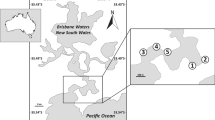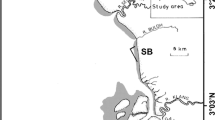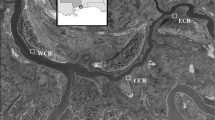Abstract
Coastal salt marshes in the northern Gulf of Mexico are often highly fragmented, with a large amount of marsh edge, the interface between the vegetated marsh surface and shallow open water. Nekton predators, including many juvenile fishery species, aggregate near this marsh edge, and benthic infaunal populations are a primary source of prey for many of these predators. We examined the fine-scale (1–10 m) distributions of benthic infauna in relation to the edge of a Texas, USA salt marsh. Every six weeks for nearly a year, we sampled marsh sediments at five locations: on nonvegetated bottom 1 m from the marsh edge and on the vegetated marsh surface at 1, 3, 5, and 10 m from the edge. Surface-dwelling annelid worms and peracarid crustaceans were most abundant in low-elevation sediments near the marsh edge for most sampling periods. Because the marsh slope varied within the study area, we could distinguish between correlative relationships with elevation and distance from the marsh edge. Distributions of common surface-dwelling species were often unrelated to elevation but almost always negatively related to distance from the marsh edge. Abundances of near-surface direct deposit feeders and omnivores were related to both distance from edge and elevation. In contrast to surface dwellers, densities of abundant subsurface deposit feeders (mainly oligochaetes) were frequently greatest in sediments located away from the marsh edge. Surface and near-surface dwelling infauna are an important prey resource for nekton, including many juvenile fishery species that concentrate near the marsh edge. Populations of these infaunal prey fluctuated seasonally, with the greatest densities occurring during winter and early spring when predator abundances are generally low. Infaunal densities decreased dramatically near the marsh edge from the late spring through early fall, and this decrease coincides with historically high seasonal densities of nekton predators. Our data suggest that there is a strong trophic link between infauna and nekton near the marsh edge and that this relationship contributes to the high fishery productivity derived from Gulf Coast marshes.
Similar content being viewed by others
Literature Cited
Andrews, J. 1971. Sea Shells of The Texas Coast University of Texas Press, Austin, TX, USA.
Baltz, D. M., C. Rakocinski, and J. W. Fleeger. 1993. Microhabitat use by marsh-edge fishes in a Louisiana estuary, Environmental Biology of Fishes 36:109–126.
Bousfield, E. L. 1973. Shallow-Water Gammaridean Amphipods of New England. Cornell University Press, Ithaca, NY, USA.
Brown, J. H. 1995. Macroecology, University of Chicago Press, Chicago, IL, USA
Connell, J. H. 1972. Community interactions on marine rocky intertidal shores. Annual Review of Ecology and Systematics 3:61–104.
Currin, C. A., S. Y. Newell, and H. W. Paerl. 1995. The role of standing dead Spartina alterniflora and benthic microalgae in salt marsh food webs: considerations based on multiple stable isotope analysis. Marine Ecology Progress Series 121:99–116.
Dayton, P. K. 1971. Competition, disturbance and community organization: the provision and subsequent utilization of space in a rocky intertidal community. Ecological Monographs 41:351–389.
Deegan, L. A., J. E. Hughes, and R. A. Roundtree. 2000. Salt marsh ecosystem support of marine transient species p. 333–365. In M. P. Weinstein and D. A. Kreeger (eds.) Concepts and Controversies in Tidal Marsh Ecology. Kluwer Academic Publishers, Dordrecht, The Netherlands.
Dean, W. E. 1974. Determination of carbonate and organic matter in calcareous sediments and sedimentary rocks by loss of ignition: comparison with other methods. Journal of Sediment Petrology 44:242–48.
Feller, R. J. 1991. Dietary analysis of peneaid shrimp: the immunoassay approach. p. 141–156. In P. DeLoach, W. J. Dougherty, and M. A. Davidson (eds.) Frontiers in Shrimp Research. Elsevier, Amsterdam, The Netherlands.
Flint, R. W. and J. A. Younk. 1983. Estuarine benthos: long-term community structure variations, Corpus Christi Bay, Texas. Estuaries 6:126–141.
Folk, R. L. 1980. Petrology of Sedimentary Rocks. Hemphill Publishing Co., Austin, TX, USA.
Gaston, G. R. and J. C. Nasci. 1988. Trophic structure of macrobenthic communities in the Calcasieu Estuary, Louisiana. Estuaries 11:201–211.
Harvey, J. W., P. F. Germann, and W. E. Odum. 1987. Geomorphological control of subsurface hydrology in the creekbank zone of tidal marshes. Estuarine, Coastal and Shelf Science 25:677–691.
Heard, R. W. 1982. Guide to common tidal marsh invertebrates of the northeastern Gulf of Mexico. Mississippi-Alabama Sea Grant Consortium, Oxford, MS, USA. MASGP-79-004.
Hummel, H., A. Meijboom, and L. D. Wolf. 1986. The effects of extended periods of drainage and submersion on condition and mortality of benthic animals. Journal of Experimental Marine Biology and Ecology 103:251–66.
Hunter, J. and R. J. Feller. 1987. Immunological dietary analysis of two penaeid shrimp species from a south Carolina tidal creek. Journal of Experimental Marine Biology and Ecology 107:61–70.
Jadhav, R. S. and S. G. Buchbergereco. 1995. Effects of vegetation on flow through free water surface wetlands. Ecological Engineering 5:481–496.
Johnson, R. G. 1970. Animal-sediment relations in shallow water benthic communities. Marine Geology 11:93–104.
Kneib, R. T. 1984. Patterns of invertebrate distribution and abundance in the intertidal salt marsh: causes and questions. Estuaries 7:392–412.
Kneib, R. T. 1985. Predation and disturbance by grass shrimp, Palaemonetes pugio Holthuis, in soft-substratum benthic invertebrate assemblages. Journal of Experimental Marine Biology and Ecology 93:91–102.
Kneib, R. T. 1986. The role of Fundulus heteroclitus is salt marsh trophic dynamics. American Zoologist 26:259–269.
Kneib, R. T. 1992. Population dynamics of the tanaid Hargeria rapax (Crustacea, Peracarida) in a tidal marsh. Marine Biology 113:437–445.
Kneib, R. T. 1997. Early life stages of resident nekton in intertidal marshes. Estuaries 20:214–230.
Kneib, R. T. 1997. The role of tidal marshes in the ecology of estuarine nekton. Oceanography and Marine Biology Annual Review 35:163–220.
Kneib, R. T. 2000. Salt marsh ecoscapes and production transfers by estuarine nekton in the southeastern U. S. p. 267–291. In M. P. Weinstein and D. A. Kreeger (eds.) Concepts and Controversies in Tidal Marsh Ecology. Kluwer Academic Publishers, Dordrecht, The Netherlands.
Kneib, R. T. and A. E. Stiven. 1978. Growth, reproduction, and feeding of Fundulus heteroclitus (L.) on a North Carolina salt marsh. Journal of Experimental Marine Biology and Ecology 31: 121–140.
Kneib, R. T. and S. L. Wagner. 1994. Nekton use of vegetated marsh habitats at different stages of tidal inundation. Marine Ecology Progress Series 106:227–238.
Kreeger, D. A. and R. I. E. Newell. 2000. Trophic complexity between producers and invertebrate consumers in slat marshes. p. 187–220. In M. Weinstein and D. A. Kreeger (eds.) Concepts and Controversies in Tidal Marsh Ecology. Kluwer Academic Publishers, Dordrecht, The Netherlands.
Lana, P. D. and C. Guiss. 1991. Influence of Spartina alterniflora on structure and temporal variability of macrobenthic associations in a tidal flat of Paranagua Bay (Southeastern Brazil). Marine Ecology Progress Series 73:231–244.
Leber, K. M. 1985. The influence of predatory decapods, refuge, and microhabitat selection on seagrass communities. Ecology 66: 1951–1964.
Levin, L. A., D. Talley, and G. Thayer. 1996. Succession of macrobenthos in a created salt marsh. Marine Ecology Progress Series 141:67–82.
Mayer, M. A. 1985. Ecology of juvenile white shrimp, Penaeus setiferus Linnaeus, in the salt marsh habitat M.S. Thesis. Georgia Institute of Technology, Atlanta, GA, USA.
Meredith, W. H. and V. A. Lotrich. 1979. Production dynamics of a tidal creek population of Fundulus heteroclitus (Linneaus). Estuarine and Coastal Marine Science 8:99–118.
McKee, K. L. and W. H. Patrick. 1988. The relationship of smooth cordgrass (Spartina alterniflora) to tidal datums: A review. Estuaries 11:143–51.
McTigue, T. A. and R. J. Zimmerman. 1998. The use of infauna by juvenile Penaeus aztecus Ives and Penaeus setiferus (Linnaeus). Estuaries 21:160–175.
Mendelssohn, I. A. and E. D. Seneca. 1980. The influence of soil drainage on the growth of salt marsh cordgrass Spartina alterniflora in North Carolina. Estuarine and Coastal Marine Science 11: 27–40.
Minello, T. J. 1999. Nekton densities in shallow estuarine habitats of Texas and Louisiana and the identification of Essential Fish Habitat. American Fisheries Society Symposium 22:43–75.
Minello, T. J. and L. P. Rozas 2002. Nekton populations in Gulf Coast wetlands: fine-scale spatial distributions, landscape patterns, and restoration implications. Ecological Applications 12:441–455.
Minello, T. J. and J. W. Webb. 1997. Use of natural and created Spartina alterniflora salt marshes by fishery species and other aquatic fauna in Galveston Bay, Texas, USA. Marine Ecology Progress Series 151:165–179.
Minello, T. J. and R. J. Zimmerman. 1983. Fish predation on juvenile brown shrimp, Penaeus aztecus Ives: the effect of simulated Spartina structure on predation rates. Journal of Marine Biology and Ecology 72:211–231.
Minello, T. J. and R. J. Zimmerman. 1991. The role of estuarine habitats in regulating growth and survival of juvenile penaeid shrimp. p. 1–16. In P. DeLoach, W. J. Dougherty, and M. A. Davidson (eds.) Frontiers in Shrimp Research. Elsevier, Amsterdam, The Netherlands.
Minello, T. J., R. J. Zimmerman, and E. X. Martinez. 1989. Mortality of young brown shrimp Penaeus aztecus in estuarine nurseries. Transactions of the American Fisheries Society 118:693–708.
Minello, T. J., R. J. Zimmerman, and R. Medina. 1994. The importance of edge for natant macrofauna in a created salt marsh. Wetlands 14:184–198.
Morris, J. T., B. Kjerfve, and J. M. Dean. 1990. Dependence of estuarine productivity on anomalies in mean sea level. Limnology and Oceanography 35:926–930.
Moy, L. D. and L. A. Levin. 1991. Are Spartina marshes a replaceable resource? A functional approach to evaluation of marsh creation efforts. Estuaries 14:1–16.
Nelson, W. G. and M. A. Capone. 1990. Experimental studies of predation on polychaetes associated with seagrass beds. Estuaries 13:51–58.
Paine, R. T. 1966. Food web complexity and species diversity. American Naturalist 100:65–75.
Peterson, C. H. and R. Black. 1988. Responses of growth to elevation fail to explain vertical zonation of suspension-feeding bivalves on a tidal flat. Occologia 76:423–429.
Peterson, C. H. 1991. Intertidal zonation of marine invertebrates in sand and mud. American Scientist 79:236–249.
Peterson, G. W. and R. E. Turner. 1994. The value of salt marsh edge vs interior as a habitat for fish and decapod crustaceans in a Louisiana tidal marsh. Estuaries 17:235–262.
Posey, M. H. and A. H. Hines. 1991. Complex predator-prey interactions within an estuarine benthic community. Ecology 72:2155–2169.
Rader, D. N. 1984. Salt-marsh benthic invertebrates: small scale patterns of distribution and abundance. Estuaries 7:413–420.
Reed, D. J. and D. R. Cahoon. 1992. The relationship between marsh surface topography, hydroperiod, and growth of Spartina alterniflora in a deteriorating Louisiana salt marsh. Journal of Coastal Research 8:77–87.
Reice, S. R. and A. E. Stiven. 1983. Environmental patchiness, litter decomposition and associated faunal patterns in a Spartina alterniflora marsh. Estuarine Coastal and Shelf Science 16:559–571.
Reise, K. 1978. Experiments on epibenthic predation in the Wadden Sea. Helgolaender Wissenschaftliche Meeresuntersuchunger 31:55–101.
Rice, W. R. 1988. Analyzing tables of statistical tests. Evolution 43: 223–225.
Rozas, L. P. and M. W. LaSalle. 1990. A comparison of the diets of gulf killifish, Fundulus grandis Baird and Girard, entering and leaving a Mississippi brackish marsh. Estuaries 13:332–336.
Rozas, L. P. and D. J. Reed. 1993. Nekton use of marsh-surface habitats in Louisiana (USA) deltaic salt marshes undergoing submergence. Marine Ecology Progress Series 96:147–157.
Rozas, L. and R. Zimmerman. 2000. Small-scale patterns of nekton use among marsh and adjacent shallow nonvegetated areas of the Galveston Bay Estuary, Texas (USA). Marine Ecology Progress Series 193:217–239.
Sacco, J. N., E. D. Seneca, and T. R. Wentworth. 1994. Infaunal community development of artificially established salt marshes in North Carolina. Estuaries 17:489–500.
Schlacher, T. A. and T. H. Wooldridge. 1996. Patterns of selective predation by juvenile, benthivorous fish on estuarine macrofauna. Marine Biology 125:241–247.
Sokal, R. R. and F. J. Rohlf. 1981. Biometry. W. H. Freeman and Company, San Francisco, CA, USA.
Stumpf, R. P. and J. W. Haines. 1998. Variations in tidal level in the Gulf of Mexico and Implications for Tidal Wetlands. Estuarine, Coastal and Shelf Science 46:165–173.
Subrahmanyam, C. B. and C. L. Coultas. 1980. Studies on the animal communities in two north Florida salt marshes Part III. Seasonal fluctuations of fish and macroinvertebrates. Bulletin of Marine Science 30:790–818.
Stoner, A. W. 1979. Species-specific predation on amphipod Crustacea by the pinfish, Lagodon rhomboides: mediation by macrophyte standing crop. Marine Biology 55:201–207.
Sudo, H. and M. Azeta. 1992. Selective predation on marine Byblis japonicus (Amphipoda: Gammaridea) by the barface cardinalfish, Apogon semilineatus. Marine Biology 114:211–217.
Thomas, J. L. 1989. A comparative evaluation of Halodule wrightii Aschers, Spartina alterniflora Loisel and bare sand as nursery habitats for juvenile Callinectes sapidus (Rathbun). M.S. Thesis. Texas A&M University, College Station, TX, USA.
Valiela, I., Wright, J. E., J. M. Teal, S. B. Volkmann. 1977. Growth, production and energy transformations in the salt-marsh killifish Fundulus heteroclitus. Marine Biology 40:135–144.
Virnstein, R. W. 1979. Predation on estuarine infauna: Response patterns of component species. Estuaries 2:69–86.
Warren, R. S. and W. A. Niering. 1993. Vegetation change on a Northeast tidal marsh—Interaction of sea-level rise and marsh accretion. Ecology 74:96–103.
Weisberg, S. B. and V. A. Lotrich. 1982. The importance of an infrequently flooded intertidal salt marsh surface as an energy source for the mummichog Fundulus heteroclitus: an experimental approach. Marine Biology 66:307–310.
Whitlatch, R. B. 1981. Animal-sediment relationships in intertidal marine benthic habitats: some determinants of deposit-feeding species diversity. Journal of Experimental Marine Biology and Ecology 53:31–45.
Wiltse, W. I., K. H. Foreman, J. M. Teal, and I. Valiela. 1984. Effects of predators and food resources on macrofauna of salt-marsh creeks. Journal of Marine Research 42:923–942.
Yelverton, G. F. and C. T. Hackney. 1986. Flux of dissolved organic carbon and pore water through the substrate of a Spartina alterniflora marsh in North Carolina. Estuarine, Coastal and Shelf Science 22:255–267.
Zimmerman, R. J. and T. J. Minello. 1984. Densities of Penaeus aztecus, P. setiferus and other natant macrofauna in a Texas salt marsh. Estuaries 7:421–433.
Zimmerman, R. J., T. J. Minello, and G. Zamora, Jr. 1984. Selection of vegetated habitat by brown shrimp, Penaeus aztecus, in a Galveston Bay salt marsh. Fishery Bulletin 82:325–336.
Zimmerman R. J., T. J. Minello, M. C. Castiglione, and D. L. Smith. 1990. Utilization of marsh and associated habitats along a salinity gradient in Galveston Bay. NOAA Technical Memorandum, Galveston, TX, USA. NMFS-SEFC-250.
Zimmerman R. J., T. J. Minello, E. F. Klima, and J. M. Nance. 1991. Effects of accelerated sea-level rise on coastal secondary production. p. 110–124. In H. S. Bolton (ed.) Coastal Wetlands. American Society of Civil Engineers, New York, NY, USA.
Zimmerman R. J., T. J. Minello, and L. P. Rozas. 2001. Salt marsh linkages to productivity of penaeid shrimps and blue crabs in the northern Gulf of Mexico. p. 293–314. In M. P. Weinstein and D. A. Kreeger (eds.) Concepts and Controversies in Tidal Marsh Ecology. Kluwer Academic Publishers, Dordrecht, The Netherlands.
Author information
Authors and Affiliations
Corresponding author
Rights and permissions
About this article
Cite this article
Whaley, S.D., Minello, T.J. The distribution of benthic infauna of a Texas salt marsh in relation to the marsh edge. Wetlands 22, 753–766 (2002). https://doi.org/10.1672/0277-5212(2002)022[0753:TDOBIO]2.0.CO;2
Received:
Revised:
Accepted:
Issue Date:
DOI: https://doi.org/10.1672/0277-5212(2002)022[0753:TDOBIO]2.0.CO;2




